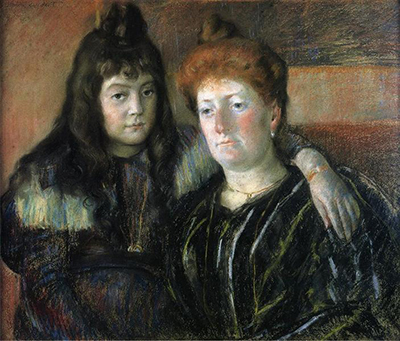Madame Meerson and her Daughter is a double portrait produced by Mary Cassatt at the very end of the 19th century. It pictures two figures dressed in black, with solemn facial expressions.
Madame Meerson sits on the right hand side, with a pin stripe shirt or blouse, red hair and relatively heavy makeup. Her daughter sits beside her and puts her left arm over her mother's shoulder as a gesture to comfort her. The daughter wears a thick looking dress with white decoration around the shoulders. Her hair hangs over, though fairly limp and without life. They sit in front of a background which is vague and non-descript, as the artist avoids distracting us away from the two figures. The entire atmosphere is one of negativity and sadness, almost as if these two are grieving a loss in the family. This is not the usual approach taken by the artist, who tended to prefer brighter colours schemes and happier settings. That said, mother and daughter seens were certainly not uncommon within her career, and she specialised in portraiture, with a focus typically on women and their offspring, normally toddlers or babies. She was joined by Berthe Morisot who played a similar role in helping women to get a greater involvement within the French art scene.
This artwork was produced using pastels and Cassatt was famous for her work within this medium, producing huge numbers of pastel drawings over several decades. Some appeared whilst she was in her mid-twenties, whilst others appeared far later in her career. She loved the way in which colour could take off, as opposed to standard drawings techniques such as charcoal and chalk. That said, she does not attempt a bright artwork here and instead concentrates on a sombre atmosphere in which two figures comfort each other and make us a little concerned as to their predicament. The only brightness is afforded to their faces, creating an idea of light coming in from the side and catching their facial features. Both have fairly lost, vague expressions in their eyes which suggests moods of melancholy that have traditionally inspired a number of inward-looking artists.
Some examples of more positive looking items to be found in the careers of artists from the Impressionist movement, as well as on the fringes, include Manet's A Bar at the Folies Bergeres, On the Beach and Boating. He was a true master of this period, but there were also a good number of other French-based painters who helped to keep Paris as the centre of the art world. It took many decades before this title was taken by New York, as we pushed deeper into the world of modern art. Cassatt and Morisot had already left a considerable legacy by then in encouraging artists to put more focus on the lives of women and also to allow women to enter the art world themselves and be treated fairly, as according to their technical ability rather than providing obstacles due to societal discrimiation.




